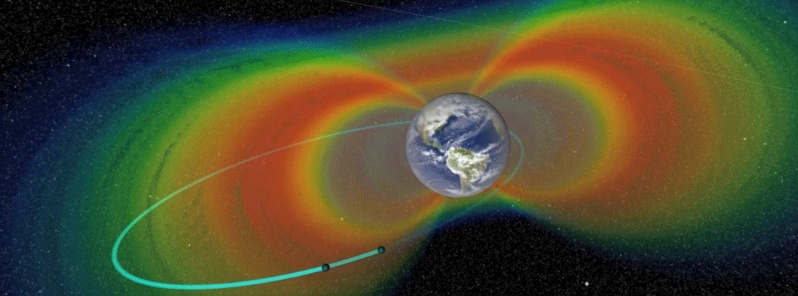Van Allen Probes begin final phase of exploration in Earth’s radiation belts

NASA's twin Van Allen Probes, launched in August 2012 and originally designed as a two-year mission, are starting a new and final phase in their exploration.
On February 12, 2019, one of the twin Van Allen Probes begins a series of orbit descent maneuvers to bring its lowest point of orbit, called perigee, just under 305 km (190 miles) closer to Earth. This will bring the perigee from about 600 km (375 miles) to about 250 km — a change that will position the spacecraft for eventual re-entry into Earth's atmosphere about 15 years.
The other of the two Van Allen Probes will follow suit in March, also commanded by the mission operations team at APL, which designed and built the satellites.
The Van Allen Probes spend most of their orbit within Earth's radiation belts: doughnut-shaped bands protons and electrons, trapped in Earth's magnetic field. These fast-moving energized particles create radiation that can interfere with satellite electronics and pose a threat to astronauts who pass through them on interplanetary journeys. The shape, size and intensity of the radiation belts changes in response to solar activity, which makes predicting their state difficult.
Each spacecraft will be moved to the lower perigee through a series of five two-hour engine burns. Because the Van Allen Probes spin while in orbit, the dates of these burns had to be chosen carefully. The needed geometry happens just once or twice per year: for spacecraft B, that period falls February 12 – 22 of this year, and for spacecraft A, it's March 11 – 22.
At the new altitude, aerodynamic drag will bring down the satellites and eventually burn them up in the upper atmosphere. The mission is to obtain great science data, and also to prevent more space debris.
"We’ll continue to operate and obtain new science in our new orbit until we are out of fuel, at which point we won’t be able to point our solar panels at the Sun to power the spacecraft systems," said Nelli Mosavi, project manager for the Van Allen Probes.
During their last year or so of life, the Van Allen Probes will continue to gather data on Earth's dynamic radiation belts. And their new, lower passes through Earth's atmosphere will also provide new insight into how oxygen in Earth's upper atmosphere can degrade satellite instruments, information that could help engineers design more resilient satellite instruments in the future.
Read more about what the Van Allen Probes have accomplished since 2012.
Featured image credit: NASA/Goddard

Commenting rules and guidelines
We value the thoughts and opinions of our readers and welcome healthy discussions on our website. In order to maintain a respectful and positive community, we ask that all commenters follow these rules.